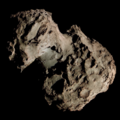Comet Brooks, formally designated as C/1893 U1, is a non-periodic comet that became visible through telescopes in late 1893. This comet might be the parent body of the Gamma Normids meteor shower (alongside C/1864 R1).[4][scientific citation needed]
Discovery and observations
William Robert Brooks spotted a new comet on the morning of 17 October 1893 from his observatory in Geneva, New York.[1] At the time of discovery, it was a 7th-magnitude object located within the constellation Virgo. One day later, Edward E. Barnard made follow-up observations of the comet, noting it had a deformed tail about 4 degrees long.[1] Barnard continued his photographic sessions of the comet throughout November 1893, documenting its changes in structure.[5] It was last observed by Herbert C. Wilson on the evening of 26 January 1894.[6]
See also
References
- ^ a b c E. E. Barnard (1893). "Photographs of Brooks' Comet (Oct. 17, 1893)". Popular Astronomy. 1 (4): 145–147. Bibcode:1893PA......1..145B.
- ^ "Comet Names and Designations". International Comet Quarterly. Retrieved 29 December 2024.
- ^ "C/1893 U1 (Brooks) – JPL Small-Body Database Lookup". ssd.jpl.nasa.gov. Jet Propulsion Laboratory. Retrieved 21 November 2023.
- ^ "March Meteor Showers Guide". LittleAstronomy.com. Retrieved 29 December 2024.
- ^ E. E. Barnard (1899). "1893 Brooks's Comet" (PDF). Monthly Notices of the Royal Astronomical Society. 59 (6): 358–370. Bibcode:1899MNRAS..59..358B. doi:10.1093/mnras/59.6.358.
- ^ G. W. Kronk (2003). Cometography: A Catalog of Comets. Vol. 2: 1800–1899. Cambridge University Press. pp. 711–714. ISBN 978-0-521-58505-7.
External links
- C/1893 U1 at the JPL Small-Body Database











You must be logged in to post a comment.